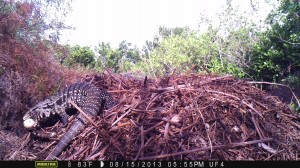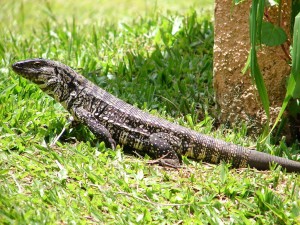
Four feet of trouble for Everglades wildlife
SHARK VALLEY, Fla.— There’s a new threat crawling around the swamps and sawgrass marshes of the Everglades.
As if the ecosystem wasn’t fragile enough, irresponsible pet owners have given the national park another gift that keeps on giving: the Argentine black and white tegu.
The South American lizard (usually pronounced tay-goo) seems harmless. As babies, they measure only a couple of inches and, even though as adults they grow to be four feet long on average, size is not the problem.
“They eat pretty much everything,” said Michelle McEachern, who specializes in invasive species at the U.S. Geological Survey and is based in Homestead.
As omnivores, they eat anything from small mammals, to rats, birds and insects. However, the biggest concern is that they’re “egg specialists,” said McEachern. “They really like eating eggs and we have a lot of ground nesting birds and other mammals.”
Liz Barraco, who works at the Florida Fish and Wildlife Conservation Commission, said that, as of now, the tegus, spotted in the park for the first time in June 2011, are located in the eastern periphery of the Everglades. Not coincidentally, this is one of the main areas where native animals lay their eggs.
For the already threatened American alligator, tegus further complicate the situation.
“We already have evidence that they eat crocodile and alligator species’ eggs,” Barraco said. This is especially devastating for the survival of the species.
 |
A tegu is captured by research cameras taking an egg from a crocodile nest (Photo courtesy of the University of Florida). |
But it’s not just their wide diet, argues Don Finefrock, executive director of the South Florida National Parks Trust. Just the fact that they’re a non-native species is problematic.
“The alligator is a symbol of the Everglades National Park and to lose their numbers would be devastating,” said John Adornato, Sun Coast Region director for the National Parks Conservation Association.
“The animals, the birds and other wildlife that are native, really have no defense mechanisms,” he said. “They’re not expecting to see a tegu lizard.”
The only bright side of the situation is that eliminating the tegus from the Everglades is still possible.
“If left unchecked, they could have a similar impact that pythons have,” said McEachern.
Tegus are easier to catch than pythons. Their black and white patterned skin stands out in the park’s landscape. In addition, Finefrock said, the tegus are not as well adapted to their new home as the pythons.
 |
The tegu’s black and white skin stands out in the Everglades landscape (Photo courtesy of Signey). |
The South Florida National Parks Trust gave a $12,000 grant at the beginning of the year to the Everglades to support an intern program. Usually biology students, one of the interns’ assignments was to set traps for tegu lizards. Inside the traps, chicken eggs have been proven to be the best bait.
“The park was very pleased with how the project went,” said Finefrock.
The interns, as of September, had captured 48 tegus.
“It represents a significant increase over captures from the previous year,” Finefrock stated.
Of the tegus captured, some go to research centers, while others are euthanized.
“This is not somebody’s pet. These are animals in the wild and on the lose,” said Finefrock. “There’s no place for them to go. It’s not their fault, but they’re here.”
Since it’s still early, Adornato is adamant that action needs to happen sooner rather than later.
“This has got to be the same kind of action we take in any kind of war,” he said. “When there is an attack we should get to the bottom of it immediately, because if we don’t, it will fester and it will turn into what happened with the python, and we cannot let this happen to the Everglades National Park.”
Thankfully, at least some are taking action.
If You See One
- Take a picture, note the location, and report the sighting. Call 1-888-Ive-Got1 (1-888-483-4681) or online at http://IveGot1.org. There’s also an app, IveGot1.
- If you see a tegu on your property and want it removed, you can contact a local wildlife trapper to remove the animal. A list of trappers can be found at http://MyFWC.com.

Comments are Closed